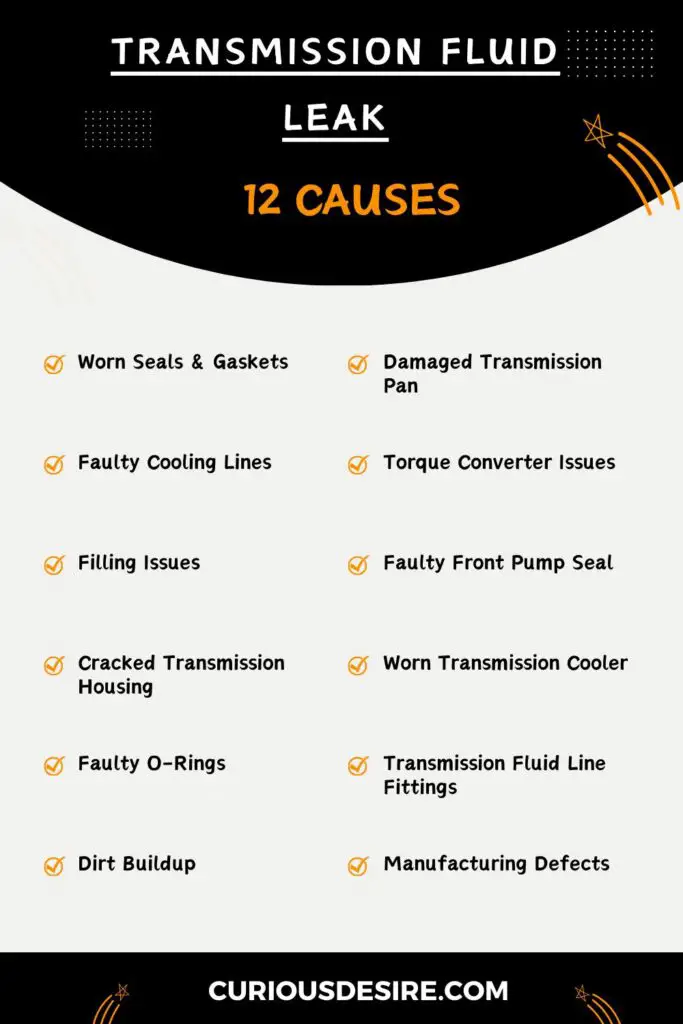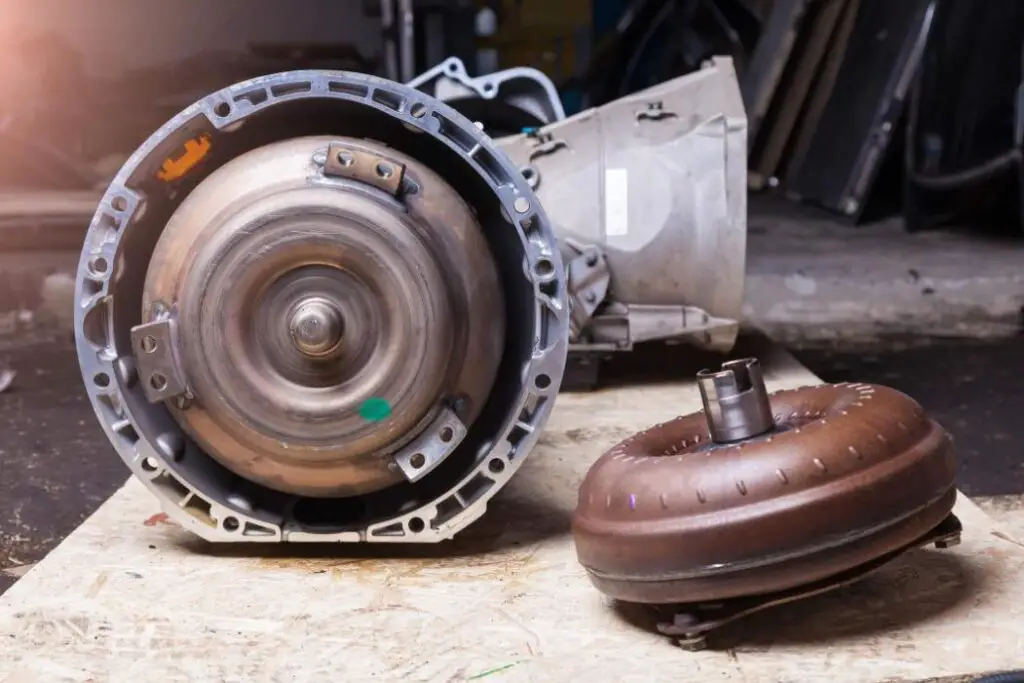The transmission system in a vehicle plays an important role in ensuring smooth and efficient power delivery.
However, like any complex system, it is susceptible to issues that can compromise its functionality.
One common and concerning problem faced by vehicle owners is the occurrence of transmission fluid leaks.
Transmission fluid serves as a vital lubricant, coolant, and hydraulic fluid within the transmission system, and any leakage can lead to a range of issues, from diminished performance to severe damage.
In this article, we’ll explore the causes of transmission fluid leaks. By understanding these causes, vehicle owners can take preventive measures to avoid long-term issues.
So let’s get into it!
Here are the top 5 causes of transmission fluid leak:
- Damaged Transmission Pan
- Torque Converter Issues
- Faulty Front Pump Seal
- Dirt Buildup in Transmission Fluid
- Damaged Seals and Gaskets
[toc]

Cause 1: Worn or Damaged Seals and Gaskets
One common reason for transmission fluid leaks is the wear and tear of seals and gaskets within the transmission system.
Over time, these rubber components can degrade due to exposure to heat and friction, resulting in cracks or loss of elasticity.
The input and output shaft seals, in particular, are prone to deterioration. When these seals fail, they allow transmission fluid to escape, leading to leaks.
Regular inspections and timely replacement of worn seals and gaskets are essential to maintain the integrity of the transmission system.
Cause 2: Loose or Damaged Transmission Pan
The transmission pan, located at the bottom of the transmission, houses the fluid. If the pan is not properly sealed or if its bolts are loose, it can lead to leaks.
Additionally, damage to the pan itself, often caused by road debris or other impacts, can compromise its ability to contain the transmission fluid.
Regularly checking and tightening the transmission pan bolts and promptly addressing any damage can help prevent leaks and ensure the proper functioning of the transmission.
Cause 3: Faulty Transmission Cooling Lines
Transmission cooling lines are responsible for carrying fluid to and from the transmission cooler, which helps regulate the fluid temperature.
Corrosion, wear, or damage to these lines can result in fluid leaks. Regularly inspecting the cooling lines and promptly addressing any issues, such as replacing corroded lines, can prevent leaks and maintain optimal transmission performance.
Cause 4: Torque Converter Issues
The torque converter, a key component in the automatic transmission system, can develop issues that lead to leaks.
A cracked housing or a damaged torque converter seal can allow transmission fluid to escape.
Regular maintenance, including checking for torque converter issues during transmission inspections, is crucial for preventing leaks and ensuring the longevity of the transmission.

Cause 5: Overfilling or Underfilling
Maintaining the correct fluid level is crucial for properly functioning the transmission. Overfilling can lead to excessive pressure on seals and gaskets, causing leaks.
Conversely, underfilling can result in inadequate lubrication and overheating.
Following the manufacturer’s specifications for fluid levels during fluid changes and regularly checking levels can help prevent these issues and avoid leaks.
Cause 6: Faulty Front Pump Seal
The front pump is responsible for circulating transmission fluid throughout the system. A damaged or worn front pump seal can lead to leaks.
This seal is essential for maintaining proper fluid pressure. Regular inspections during routine maintenance and addressing any front pump seal issues promptly can prevent leaks and ensure the smooth operation of the transmission.
Cause 7: Cracked or Damaged Transmission Housing
The transmission housing, which encases various components of the transmission system, can develop cracks or damage. Physical impact, corrosion, or manufacturing defects may contribute to such issues.
When the housing is compromised, it can result in fluid leaks. Regular inspections for visible damage and addressing any issues with the transmission housing are vital for preventing leaks and maintaining the overall structural integrity of the transmission.
Cause 8: Worn or Damaged Transmission Cooler
The transmission cooler plays a crucial role in regulating the temperature of the transmission fluid. Over time, internal corrosion or external damage can compromise its effectiveness, leading to fluid leaks.
Regularly checking the condition of the transmission cooler and addressing any issues promptly, such as replacing a damaged cooler, can prevent leaks and ensure the transmission operates within optimal temperature ranges.
Cause 9: Faulty O-Rings
O-rings are essential components used in various parts of the transmission system to create a secure seal. When these rubber rings become worn or damaged, they can contribute to fluid leaks.
Regular inspections during routine maintenance, focusing on areas where O-rings are used, can help identify and replace any worn or damaged O-rings, preventing leaks and maintaining the integrity of the transmission system.

Cause 10: Transmission Fluid Cooler Line Fittings
The fittings that connect the transmission fluid cooler lines play a crucial role in maintaining a secure connection.
Over time, these fittings can become loose or damaged, leading to transmission fluid leaks.
Regularly checking and tightening these fittings during routine maintenance is essential for preventing leaks.
When left unaddressed, loose or damaged fittings can compromise the efficiency of the transmission cooling system, potentially causing overheating and long-term damage.
A thorough inspection should include not only the fittings themselves but also the surrounding areas for signs of fluid seepage, ensuring early detection and timely repairs.
Cause 11: Dirt Buildup in Transmission Fluid
Dirty buildup in the transmission fluid can result in fluid leaks by causing multiple issues within the transmission system.
Over time, contaminants can accelerate the wear and deterioration of seals and gaskets, compromising their ability to maintain a proper seal and leading to leakage.
Additionally, the presence of debris can increase friction between moving parts, wearing down critical components and contributing to fluid leaks.
Clogging of small passages and channels within the transmission, due to dirt and sludge accumulation, disrupts fluid flow and elevates pressure, forcing fluid past weakened seals.
Contaminants may also contain abrasive or corrosive elements, contributing to the corrosion of metal components, and further increasing the risk of leaks.
To prevent these issues, regular maintenance, including changing the transmission fluid and replacing the filter as recommended, is essential to maintain fluid cleanliness, reduce the risk of contaminants, and extend the lifespan of transmission components.
Cause 12: Manufacturing Defects
In rare instances, manufacturing defects in transmission components can contribute to fluid leaks. While less common, these defects may include flaws in seals, gaskets, or other critical parts.
If there’s a problem with your vehicle because of manufacturing issues, the manufacturer might issue a recall or a service bulletin to let you know about it. Car owners must pay attention to these notices.
If you stay alert and take action based on the manufacturer’s advice, you can minimize the chances of having problems like leaks due to manufacturing defects.
Keep an eye out for any updates from the vehicle manufacturer, so you’re aware of potential issues, and if there’s a recommended fix or solution, make sure to address it promptly.
This way, you can keep your vehicle in good condition and avoid any issues related to manufacturing defects.
Transmission Fluid Leak Causes – FAQs
1. How much does it cost to fix a transmission fluid leak?
The cost of fixing a transmission fluid leak can vary depending on the severity of the leak and the make and model of the vehicle.
On average, it may range from a few hundred to over a thousand dollars.
2. Is it OK to drive with a transmission fluid leak?
Driving with a transmission fluid leak is not recommended. Low transmission fluid levels can lead to serious damage to the transmission, affecting its performance and longevity. It’s crucial to address leaks promptly.
3. How do you stop transmission fluid from leaking?
Stopping a transmission fluid leak involves identifying the source and repairing or replacing the damaged components.
Common solutions include fixing seals, and gaskets, or replacing faulty transmission lines. Consult a mechanic for a proper diagnosis and repair.
4. How do I find out where my transmission fluid is leaking from?
To identify the source of a transmission fluid leak, inspect the transmission and surrounding components for wet or oily spots.
Clean the area, drive the vehicle briefly, and then check for fresh leaks.
A UV dye can also be added to the fluid for easier detection under UV light.
5. What are three issues that can be caused by low fluid levels in a transmission?
- Overheating: Low fluid levels can lead to increased friction, causing the transmission to overheat.
- Slipping Gears: Inadequate fluid affects the transmission’s ability to engage gears properly, resulting in slipping or erratic shifting.
- Premature Wear: Insufficient lubrication can lead to increased wear and tear on transmission components, reducing their lifespan.
6. What color is transmission fluid when it leaks?
Transmission fluid is typically red or brown. If you observe a reddish or brownish puddle beneath your vehicle, it may indicate a transmission fluid leak.
7. What is the most common transmission fluid leak?
The most common transmission fluid leak occurs at the transmission pan gasket. Over time, the gasket can deteriorate or become misaligned, leading to fluid seepage.
8. How do I know if I’m leaking oil or transmission fluid?
Check the color and consistency of the fluid. Transmission fluid is red or brown, while engine oil is typically darker and has a thicker consistency.
Additionally, the location of the leak and the associated smell can provide clues.
9. What happens when transmission fluid leaks?
When transmission fluid leaks, it can lead to low fluid levels, resulting in overheating, slipping gears, and increased wear.
Failure to address the leak promptly can cause significant damage to the transmission, leading to costly repairs or replacement.